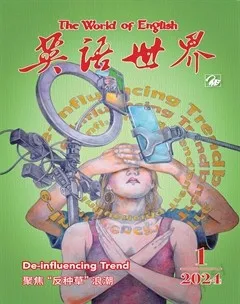A Brief History of “Auld Lang Syne1”Auld Lang Syne的往昔与今朝
凯特琳·施奈德/文 魏雨萱/译
Every New Year’s Eve, after the champagne has been popped, the ball has dropped2, and everyone is feeling very merry indeed, revelers queue up the same song they’ve been queuing up for decades. You know the one—it makes you cry, even though you don’t understand it and know almost none of the words.
每年新年前夕,香槟已开,倒计时水晶球已降下,人人都沉浸在喜悦之中。就在此时,狂欢的人们纷纷唱起同一首歌,那是一首他们已经唱了几十年的歌。你一定听过,即使你听不懂,几乎不知道歌词,你也会闻之而落泪。
A handful of options pop up when you search for the meaning of “auld lang syne”: “times/days gone by,” “old time’s sake,” “long long times/ago,” and even “once upon a time” among them. The most common consensus is something like “for old time’s sake,” which is about as direct an interpretation as you can get, as the word-for-word translation is “old long since.” The line about “for auld lang syne” is essentially “for (the sake of) old times.” (For the record, it never says the totally nonsensical3 “for the sake of auld lang syne.”) Beyond the words themselves, there’s even less agreement about exactly how the tune came to be a New Year’s Eve tradition.
搜索auld lang syne的釋义会得到几个选项:times/days gone by(流逝的时光/过去的日子)、old time’s sake(念往昔)、long long times/ago(很久很久以前),甚至还有once upon a time(从前)。其中,最普遍认可的是for old time’s sake(念往昔),这是你能得到的最直接的解释,因为逐字翻译过来就是old long since(过去的时光)。歌词for auld lang syne其实就是“for (the sake of) old times”。(特此声明,并不存在for the sake of auld lang syne这种荒谬的说法。)除了歌词本身,关于这首歌是如何成为新年前夕传统曲目的,人们更是众说纷纭。
For old time’s sake
念往昔
The song originated as a poem, but it probably wasn’t written by Robert Burns4, as is commonly believed—at least not entirely. The poet was simply the first person to write down an old Scottish folk song (it bears more than a passing resemblance to5 “Old Long Syne,” a ballad that was printed by James Watson in 1711). Burns himself said, “I took it down from an old man,” and whether it was transcribed or co-authored, it’s safe to say that the “Auld Lang Syne” we know today is some combination of an old poem and Burns’s creative input.
这首歌最初是一首诗,但这首诗可能并不像人们普遍认为的那样由罗伯特·彭斯创作而成,至少不完全是。这位诗人只是第一个将某首古老苏格兰民谣记录下来的人。(这首民谣与詹姆斯·沃特森于1711年发表的民谣Old Long Syne极为相似。)彭斯自称“根据一位老人的口传记录下了这首民谣”,但无论是逐字记录的,还是共同创作的,可以肯定地说,我们今天所知的Auld Lang Syne是一首古诗与彭斯的独特创作相结合的产物。
In any case, Burns sent a copy of the poem to a friend in 1788 and wrote: “There is more of the fire of native genius in it than in half a dozen of modern English Bacchanalians6!” Later he contributed it to The Scots Musical Museum.
总之,彭斯在1788年将这首诗的副本寄给一位朋友,并写道:“这首诗里熊熊燃烧的苏格兰民族特质之火,比六场现代英国酒神仪式的狂欢之火还要热烈。”后来,他把诗稿贡献给了《苏格兰音乐博物馆》一书。
Five years later, Burns wrote to James Johnson, who was assembling a book of old Scottish songs: “The following song, an old song, of the olden times, and which has never been in print, nor even in manuscript until I took it down from an old man.”
那是五年之后,彭斯致信詹姆斯·约翰逊,后者当时正在汇编一本苏格兰古老歌曲集(即《苏格兰音乐博物馆》)。彭斯写道:“附上的这首歌是一首来自过去的古老歌曲,在我从一位老人那里将它记录下来之前从未发表过,甚至连手稿都没有。”
It’s unclear whether Johnson linked Burns to the song in his credits, but by the time the book was published in 1796, the poet was dead. He’d never know that those words would eventually help secure his own cultural immortality.
目前还不清楚约翰逊有没有在他的书中将彭斯与这首歌联系在一起,但当这本书于1796年出版时,彭斯已经去世了。他永远不会知道,那些歌詞最终使他成为永垂不朽的文化名人。
Name that tune
定曲调
The words aren’t the only element that evolved over the years; it’s believed that the original tune is different than the one we drunkenly hum along to today. Originally, the song had a more traditional folk sound, one that can be heard in (of all things) 2008’s Sex and the City movie. This version is still performed today, but with much less frequency than the New Year stand-ard. The melody we all know was used at the suggestion of music publisher George Thompson.
这么多年来,这首歌并非只有歌词在变化,据信它最初的曲调也不同于如今我们醉醺醺哼唱的调子。最初的曲调更偏向传统民谣,在2008年的电影《欲望都市》(竟然是这部)中可以听到。这一版本至今仍在演奏,但远不如新年前夕的版本演奏得多。我们所熟知的旋律是在音乐出版商乔治·汤普森的建议下采用的。
How then did a Scottish folk song with a murky provenance7 and nothing at all to do with New Year’s Eve become associated with the holiday? It’s largely thanks to bandleader Guy Lombardo8. In 1929, Lombardo and his band played “Auld Lang Syne” as transitional music while performing at New York City’s Roosevelt Hotel during a New Year’s Eve broadcast. It was played just after midnight, and heard over radio and television airwaves.
那么,这样一首来历不明又和新年前夕毫无关系的苏格兰民谣,是如何与新年联系到一起的呢?这主要归功于乐队领队盖伊·隆巴尔多。1929年,隆巴尔多和他的乐队在纽约罗斯福酒店进行新年前夕特别节目演出时,演奏了Auld Lang Syne用于转场。此时零点刚过,悠扬的曲调通过收音机和电视传播开来。
A global tradition
成为全球传统曲目
Today, “Auld Lang Syne” is one of the most recognizable songs around the world, where it’s played at funerals, at celebrations, and as a warning that closing time is approaching at stores throughout Japan.
如今,Auld Lang Syne是全世界最耳熟能详的歌曲之一,无论是葬礼上,还是庆典中,都会播放这首歌曲。日本各地的商店还会播放这首歌来提醒顾客快到打烊时间了。
To impress your date on New Year’s Eve, learn the correct words here—and don’t worry too much about the meaning. As Sally Albright says in When Harry Met Sally..., “Anyway, it’s about old friends.”
想在新年前夕惊艳你的约会对象吗?来学习正确的歌词吧,不用太过纠结歌词的含义。正如电影《当哈利遇到莎莉》里女主角莎莉·奥尔布赖特所说,“总之,这歌和老友有关”。
(译者为“《英语世界》杯”翻译大赛获奖者;单位:广东外语外贸大学)
1苏格兰传统民歌,歌名在中国普遍译为“友谊地久天长”。 2指纽约时报广场跨年夜倒计时的水晶球降落仪式。这个仪式历史悠久,是美国极具标志性的迎新年活动之一。 3 nonsensical荒谬的;无意义的。
4罗伯特·彭斯(1759—1796),苏格兰杰出的民族诗人,代表作有A Red Red Rose(《一朵红红的玫瑰》)。 5 bear more than a passing resemblance to酷似。 6 Bacchanalian酒神节的;狂欢作乐的;纵酒狂欢的人。酒神节(Bacchanalia)是希腊罗马宗教中对酒神表达敬意的节日,庆祝活动包括戏剧表演和饮酒盛宴等。
7 provenance出处;起源。 8盖伊·隆巴尔多(1902—1977),生于加拿大的美国伴舞乐队领队,于1924年组建伴舞乐队The Royal Canadians。从1929年12月31日开始,盖伊·隆巴尔多及其乐队的新年前夕特别节目成为美国新年庆典的重要组成部分,隆巴尔多也因此被称为“新年前夕先生”(Mr. New Year’s Eve)。

